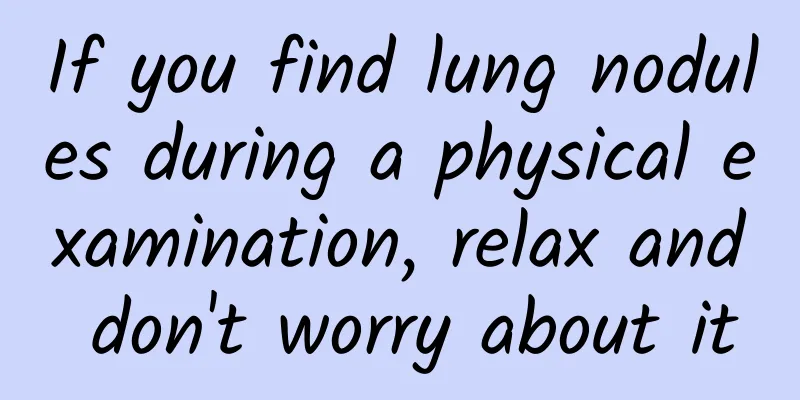If you find lung nodules during a physical examination, relax and don't worry about it

|
Author: Chen Zhenbo, deputy chief physician of Beijing Boai Hospital, China Rehabilitation Research Center Reviewer: Liu Min, Chief Physician, China-Japan Friendship Hospital With the development of society and the improvement of people's health awareness, more and more people will have regular physical examinations in order to promptly detect and deal with potential health problems. As a common problem found in physical examinations, lung nodules often cause concern and anxiety among the public due to the publicity of some unprofessional self-media marketing accounts. In fact, there is no need to be too entangled in lung nodules found during physical examinations. Lung nodules are not equivalent to lung cancer, and the vast majority of nodules are benign. Based on the author's work experience and several issues of concern to the public, this article explains the relevant knowledge of lung nodules in plain language to help everyone correctly understand and deal with this problem. 1. Definition and classification of pulmonary nodules Pulmonary nodules refer to round or quasi-circular high-density shadows with a diameter of less than or equal to 3 cm that appear in the lungs. They can be single or multiple, and their formation causes vary. According to the density of the nodules, we can divide them into solid nodules, mixed density nodules, and ground glass nodules. Among them, solid nodules have a higher density and cover the lung texture; some solid nodules contain both solid and ground glass components; ground glass nodules are like frosted glass, and the lung texture inside the nodule is still visible. It is worth noting that lesions larger than 3 cm are called masses and do not fall into the category of pulmonary nodules. 2. Common causes of pulmonary nodules Figure 1 Copyright image, no permission to reprint The formation of lung nodules is related to many factors. The following are some common causes. 1. Lung infection: When microorganisms such as bacteria, viruses or fungi infect the lungs, they may trigger an inflammatory response, which in turn leads to the formation of nodules. These nodules are usually benign and may gradually shrink or disappear as the inflammation subsides. 2. Old lesions: Some people may be found to have some old lesions in their lungs during physical examinations, which are scar tissues left by previous pneumonia, tuberculosis, etc. These scars may appear as nodular high-density shadows during physical examinations. 3. Benign tumors: Benign tumors may also occur in the lungs, such as pulmonary hamartomas, etc. These tumors usually grow slowly and have little impact on physical health. 4. Lung cancer: Although lung cancer is one of the possible causes of lung nodules, even if nodules are found, they are not necessarily malignant and a comprehensive judgment is needed based on the condition of the nodules. 5. Other factors: including some non-infectious factors, such as long-term smoking, exposure to chemicals or dust, etc. 3. Evaluation and management of pulmonary nodules Figure 2 Copyright image, no permission to reprint When you discover a lung nodule during a physical examination, your doctor will usually perform further evaluation to determine the nature of the nodule and the treatment plan. The following is a general evaluation and treatment process. 1. Detailed inquiries about medical history: The doctor will ask about your medical history in detail, including previous lung diseases, smoking history, occupational exposure, etc., to obtain more clues about the formation of nodules. 2. Imaging examination: The doctor may recommend more detailed imaging examinations, such as CT scan or PET-CT, etc. These examinations can provide more information about the shape, size, location of the nodules, and whether there is metastasis. 3. Observation of nodule size and morphology: Generally speaking, nodules smaller than 8 mm are considered low risk, while nodules larger than 8 mm require closer monitoring. The morphology of the nodule is also an important indicator for assessing its nature. Benign nodules usually have smooth edges and regular shapes, while malignant nodules may have irregular shapes such as lobed or burred. 4. Regular follow-up: For most people, if the nodules are considered benign or low-risk, doctors usually recommend regular follow-up observation. This means that after the lung nodules are found, regular physical examinations and imaging examinations are required as recommended by the doctor to monitor the changes of the nodules. 5. Further examination or treatment: If the nodule appears to be larger, changes in shape, or has other symptoms during follow-up, the doctor may recommend further examination or treatment. This may include puncture biopsy, surgical resection, or other targeted treatments. 4. Why don’t we worry about lung nodules? There are several reasons for this. 1. Most nodules are benign: As mentioned earlier, there are many reasons for the formation of lung nodules, most of which are benign, which means they do not cause serious impact on physical health and do not require special treatment. 2. Regular follow-up is an effective monitoring method: Through regular follow-up observation, doctors can promptly detect changes in nodules and take appropriate treatment measures. This monitoring method is of great significance for early detection of potential problems and treatment. 3. Overtreatment may bring risks: For some low-risk nodules, overtreatment may bring unnecessary risks and burdens. Therefore, it is a wise choice to avoid overtreatment when there is no sufficient evidence that the nodule is malignant. 4. Maintaining good living habits can help prevent: The formation of lung nodules can be prevented by maintaining good living habits. This includes quitting smoking, avoiding long-term exposure to harmful substances, maintaining a balanced diet and proper exercise. These measures can help enhance the body's immunity and reduce the occurrence of lung diseases. 5. Psychological adjustment is equally important: Facing the lung nodules found during the physical examination, we need to maintain a positive attitude and make appropriate psychological adjustments. Anxiety and fear may have a negative impact on physical health, while a positive and optimistic attitude will help to better cope with this problem. 5. Response and prevention of pulmonary nodules Figure 3 Copyright image, no permission to reprint Although it is not a big deal to discover lung nodules during a physical exam, you still need to take some steps to deal with and prevent potential problems. Here are some suggestions. 1. See a doctor promptly and follow the doctor's advice: When lung nodules are found during a physical examination, you should see a doctor promptly and follow the doctor's advice. Because the judgment of benign or malignant lung nodules is a very professional medical issue, do not search or read some self-media or marketing propaganda on your computer or mobile phone, and scare yourself and ignore the doctor's advice. 2. Maintain a healthy lifestyle: As mentioned above, maintaining good living habits is important for preventing the formation of lung nodules. You should quit smoking, avoid exposure to harmful substances, maintain a balanced diet and exercise appropriately. 3. Regular physical examinations: Regular physical examinations are an effective way to promptly detect and deal with potential health problems. Regular physical examinations should be conducted according to the doctor's advice, especially for lung examinations. 4. Pay attention to physical changes and seek medical attention in time: Pay close attention to changes in your body, especially respiratory symptoms. If you have symptoms such as coughing, sputum, and difficulty breathing, you should seek medical attention in time and undergo appropriate examinations and treatment. 5. Face it positively and seek support: When facing lung nodules found during physical examinations, we need to maintain a positive attitude and seek support from our family members. They can provide emotional support and advice to help us better cope with this problem. In summary, it is relatively common to find lung nodules during physical examinations, but there is no need to be overly entangled or anxious. Most nodules are benign, and potential problems can be discovered and treated in a timely manner through regular follow-up observations. Maintain a healthy lifestyle, have regular physical examinations, pay attention to physical changes, and seek medical treatment in a timely manner. Through scientific cognition and professional response measures, we can better manage our health and enjoy a good life. |
<<: Calcium, are you taking it correctly?
>>: Myocardial infarction is more common in autumn and winter, so don’t take it lightly!
Recommend
Is it normal to still have breast pain after medical abortion?
After a woman becomes pregnant, her body will und...
Normal hcg level in 2 weeks of pregnancy
When you are two weeks pregnant, you can go for a...
How to self-check breast disease?
Breast health has become an issue that women have...
What medicine should I take if there is a lot of leucorrhea and a strange smell?
If women have excessive vaginal discharge with an...
Why do women often get angry?
There are many types of fire, including lung fire...
Should milk powder be prepared with 40-degree or 70-degree water? Why should milk powder be prepared with 70-degree water?
We all know that milk powder is one of the staple...
Breast development at 22 years old
Women at the age of 22 are at the age of sexual m...
How to prevent breast sagging
For women who love beauty, one of the most unbear...
Why do pregnant women feel nausea and vomiting?
When a woman becomes pregnant, her body will have...
What should I do if my baby refuses to take medicine?
During the peak season of influenza, my baby had ...
How to check if the fallopian tubes are open?
Many times, because some young couples do not hav...
What is the difference between a 20 yuan juicer and a 2,000 yuan blender? Is it true that the more expensive, the better?
When it comes to fruit, everyone knows that it is...
[Medical Q&A] Are tinea corporis and eczema the same thing?
Planner: Chinese Medical Association Reviewer: Pr...
What are the symptoms and causes of empty sac during pregnancy?
Pregnancy is great news for a family. It not only...









